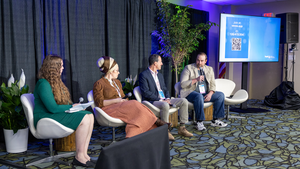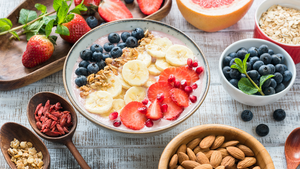Consumer data paints picture of ‘new normal’ in the time of COVID-19 – podcast
How have consumer shopping and behavior trends shifted during the time of COVID-19?
The COVID-19 pandemic, even as local and national governments begin easing social restrictions, continues to plague the food and beverage industry. Now nearly three months into this “new normal,” social distancing and increased sanitization efforts continue, all while millions of Americans remain out of work or otherwise struggling financially.
The question for food and beverage brands is, how is this affecting consumers? How have shopping and eating habits been adjusted, and what are consumers focused on when it comes to the food and beverages they purchase and consume?
To get a clearer picture of what is driving consumers now, how that compares to pre-COVID times, and perhaps what it might say about a post-COVID world, Food & Beverage Insider spoke to Eric Pierce, who works with Informa’s NEXT Data & Insights team. In this podcast, Pierce explains some of the consumer data coming out during this time, including not only what consumers say is most important to them, but what actions they are taking in response.
With Food & Beverage Insider assistant editor Alex Smolokoff, this podcast addresses:
The mindset of today’s consumers, and what values they hold most dear;
How shopping and social behaviors have evolved and what that means for brands, retailers and restaurants;
and what lessons we should – or shouldn’t – take with us when this period of uncertainty begins to trend back toward normalcy.
Podcast transcript:
Alex Smolokoff: Welcome to another edition of the Food and Beverage Insider podcast. I'm Alex Smolokoff and with me on the phone today I have Eric Pierce who works with informants NEXT data and insights team. Thank you for joining me today Eric
Eric Pierce: Yeah, absolutely, thanks for having me.
Smolokoff: So, with so much still up in the air in the industry and the world at large as we continue to deal with the COVID-19 pandemic, Eric is here to discuss some consumer behaviors during the pandemic and what we might be able to learn from them. With the NEXT data insights team, they collect data through surveys and through other types of input and really put together a nice picture for us while we're doing our writing in our reports so that we kind of know what's going on with consumers and can try and point companies in the right direction and let them know really how to how to proceed, especially now during these very, very unprecedented times. So, with many restaurants still closed and many people still staying home, it's only natural that we'd see some shifts in the way people shop and consume their foods, and that's really what we're here to discuss today. So, I guess just broadly speaking I'll start with a broad question, then maybe get a little bit more specific as we go, but what kind of shifts are we seeing in consumer shopping and purchasing behaviors compared to pre-COVID? Whether that's as far as their behaviors, their mindsets, their shopping patterns. What major changes have we seen in data that's coming out lately as compared to maybe 3 months ago?
Pierce: Yeah, thanks Alex. It's really interesting actually. As you mentioned, we've been doing a lot of surveying. We have a couple of pre post surveys that we've been able to do with pre-COVID measurements that we can compare to current as well as every week we're putting out new surveys in order to build some data for this industry. Health monitor work that we're doing, but also for other content and consulting purposes. And I really expected you know, in the first set of measurements that we took that we'd expect to see sort of like, really clear patterns in terms of how people’s behaviors are shifting, and I actually think that if we were to try and say who are the winners and who are the losers in this process, that if I had to declare a winner, I would declare variety the winner, right? You know, what we're seeing is there's a good number of people who say they’re shopping local businesses more often than they did before COVID-19. At the same time we're seeing consumers say they're shopping large chain grocery stores more frequently. Others who are saying they’re shopping independent grocery stores more frequently. Some are obviously experimenting with online grocery or curbside pickup, but it's almost like there's equal proportions of people who are experimenting with each of these different strategies as opposed to there being one massive clear winner, right? So, consumers are shifting behavior to online, but we've seen maybe a 6-percentage point increase almost to 29% increase in online shopping, according to at least some survey data that we've done sort of pre-COVID to post-COVID. But again, we've also seen shifts in how people are shopping that kind of really cover the gamut of options available, so I'd say people are experimenting with lots of different strategies in order to get their needs met right now, and that's kind of the overall observation is people are experimenting with lots of things as they seek to get their needs met.
Smolokoff: One thing I'd be really interested, if there's any data that can show a trend one way or the other, is I feel like there's some competing factors at play. Almost factors that really go against each other as far as what people might be shopping for these days. On the one hand, people are kind of stuck at home, they can't really go to the gym, they might not be able to have their normal exercise or wellness routines. So, I could see consumers may be seeking out more better-for-you foods. Foods that maybe help them reach those wellness goals in ways that they can't otherwise. But I could also see you know you're stuck at home, cooking every night, maybe you get a little lazy, you just want to pop in a frozen meal or put a box of mac and cheese on the stove. So, I'm curious, are we seeing maybe an increase in either one of those types of foods or meals? Are people seeking better for you foods, or are we maybe seeing an uptick in junk type of foods or sweets and snacks and foods like that? What direction do we see consumers going with as far as the wellness of their foods?
Pierce: Yeah, great, great question. Both. And again, variety is the winner here. So, in April, the week of April 6th, we did a survey and we asked consumers compared to typical behavior in 2019, what have you done more of in the past two weeks? So again, this is the first week of April, so most people kind of went through a several week period in March where they were having to change behaviors, so people were three-ish weeks into this. What we found was 56% of people saying that they were buying what was available and were less worried about product or brand preferences. 44% of people said they were buying more affordable products, or products in larger quantities than they used to buy. But we also saw 27% of people saying I'm buying better for me products, 23% saying they were buying more natural and organic products, 18% say they were willing to and actually buying higher priced products with better health ingredients or better health benefits to them. And even 14% saying that they were buying better for the planet products more frequently now than they were in the past. And so again, what we're seeing is a little bit this idea of people employing different strategies and experimenting with different ways of getting their needs met. When we look at how they're eating at home right, 56% of people say they're cooking more meals from scratch, but 50% also say they're eating frozen meals, or boxed or canned foods more frequently. There's just a lot more consumption happening at home, and so there's a lot of opportunities for all of these things to be going up. We shifted 50% of food consumption from out of home consumption, I'm saying roughly here, roughly 50% of food consumption was out of home, and the vast majority of that had shifted to in home consumption, through grocery stores and so people do have a lot more occasions and a lot more at home consumption so that they can experiment with baking from scratch, but also baking from premixes, right? And so, we're seeing both of those different types of behaviors in the marketplace.
What I find really encouraging for those of us in the nutrition and the health and wellness space is that consumers haven't, one might have expected that given the economic pressures and the uncertainty and the reduced options that people might feel like they have available to them, well, what we have not seen is people abandoning health efforts or sustainability values. Instead, actually, we've seen some people engaging more in that, some people maybe have had to retreat or pull back a little bit, but overall, we've seen either neutral to slightly increased engagement in health and wellness-oriented topics.
Smolokoff: You touched on something that I found really interesting, which is the idea of, you know, sort of these sustainable types of foods. And obviously we know that a lot of times those types of things can come with a bit of a price premium. And with the economic uncertainty that a lot of folks are facing these days, it might be hard for people to go out and spend the money, that maybe they want to or otherwise would on some of these better for you, or better for the planet products. Have you noticed any difference as far as what consumers may say they'd like to be doing versus what they are doing? Specifically, when it comes to sustainability, where you know with everybody staying inside, we've seen you know lower air pollution and a lot of these posts online of showing sort of how nature has kind of reclaimed itself with so many people staying inside, and I think that that sustainability is really front of mind for people. But again, it is tough to maybe spend that extra couple dollars on those types of products. So, are you seeing any differences between what people say they'd like to be doing versus maybe what they're actually capable of doing right now?
Pierce: Yeah, that's a great question. So, what I don't have is retail sales data to answer the true behavior, what are people actually doing? Again, I think the retail sales data as powerful as it is, is actually a little bit hard to read right now, because again, we shifted so much spending from out of home to in home that almost every category is up in some fashion, and so to understand, you know whether people are buying more of these things just because there's more money being spent through that channel, or they're buying more of it because it's important to them is a little bit hard to read in the POS data that I've seen. I don't have that to report on, but I have asked questions in slightly different ways that will shed a little bit of light on that. One example is, again, we asked people this time the week of April 13th, would you say you're doing more or less of these things than you were in 2019 or is it more important to you? So we ask, is personal health and environmental or planetary health more or less important to you? On a personal health level, people said 2% less important, 77% said that it was more important. On an environmental inflammatory health perspective, 4% of people said it was less important to them right now, and 67% of people said it was more important. Now, that's kind of that attitude, what they believe. We tried to ask some questions that get a little bit closer to what are they actually doing? When we think about managing one’s health more proactively, we ask questions again, what are you doing more or less of now relative to 2019? What we found is things like remaining in contact with friends, proactively managing my health, getting regular exercise, eating healthy foods, taking dietary supplements or vitamins. Kind of we're all in this realm of 33% to 41% of people saying they were doing that more often and only about 7% on the low end and 13% on the high end saying they're doing those things less often. What we're seeing here is a shift from a state of behavior of about 77% of people saying it's more important to actual specific types of behaviors increasing in this realm of one third to four in ten people saying they’re doing that. We had similar questions for shopping and supporting environmental causes. What we see is if we say something as specific as you know, “are you donating to humanitarian causes more?” we only see 20% of people saying they’re doing that more, and 18% saying they’re doing that less. So we have some people when it comes to donating to support these values and beliefs, we kind of have a split. Some people are doing this more, some people are doing this less and it's almost balancing out. Buying from companies that engage in socially responsible business practices, 18% saying they're doing less of that, 24% saying they're doing more. Paralleling that one to buying from companies that say they are engaged in environmentally responsible businesses decreasing or less often for 13% of consumers and increasing for 19%. So, again those numbers are considerably lower than that 67% who said environmental health is more important but we're still seeing people shift some behavior. But again, it's unequal. Some people, probably because of financial pressures and just having other things they have to worry about, like schooling their kids and figuring out where their groceries are coming from and figuring out how to work from home. You know some people are distracted and busy and maybe investing less than that, but there are people who might well be seeing this as an important time to double down on the things that are important to them.
Smolokoff: Speaking of, you mentioned that a lot of people are doing some things that maybe they haven't had to do in the past and a big part of that is having their kids home all the time and having to sort of balance work and trying to school their children while most schools in the country are still closed. I know you said you don't have necessarily any retail sales data, but I'm curious if you've seen if peoples, specifically parents, shopping habits for their children have changed at all now that they're the ones who are sort of responsible for keeping their children fed and keep giving them snacks throughout the day as opposed to schools that may be used to sort of take control of that during the day. Are we seeing any difference in the way parents are shopping for their children? Are they either more focused on their children's health through the foods they buy versus maybe just the convenience of certain types of snacks? Is there anything that you could sort of elaborate on as far as any kind of shopping habits for parents for their children?
Pierce: Yeah, let me take a look real quick. Alex, I apologize, we have not dug into the parent data in a meaningful way at this point. I've got a data point from a research partner of ours, Suzy, that we do a lot of our work with and they have some data that suggests that parents are shopping more frequently. So, I think maybe they're struggling to meet the needs of their kids, you know, and kind of keep the pantry stocked with a larger family. They’re shopping more frequently and making daily shops almost more frequently than others, but that's the extent that I have right now on parents, I apologize I don’t have more for you.
Smolokoff: No that’s actually a really interesting point that you know, that maybe parents don't realize just how much their kids do need to eat during the day and find themselves running out of food. I know I've got family members who have kids home all day, and even just babysitting kids, you don't realize just how much food they consume during the day. So, I'm not surprised to see that parents might have to go out and restock a little bit more often than maybe they used to.
Just one or two other questions. Another question that I did have though, is I'm curious if you have any data that shows whether people are maybe getting a little bit more adventurous with the types of brands that they’re purchasing or the types of foods that they’re purchasing. I know, maybe not necessarily today, but certainly a month or six weeks ago, trying to go to a grocery store it was really just trying to get whatever you could. Shelves were pretty barren; people were stocking up and even personally myself I was forced to maybe buy some types of foods or some brands of food that I normally would not. I'm curious if you're seeing people doing that more, you know, maybe buying brands that they're not as familiar with, or trying new foods or brands, and whether you think that maybe that's something that companies, once we are kind of back into a ‘normal’ period where maybe there's more research and development going on and we can finally start to maybe get some new products onto shelves, if you think that there is any kind of increase in people's adventurism as far as the types of foods they’re eating and the brands that they're shopping, because maybe they were forced to a month or six weeks ago.
Pierce: Yeah, that's an interesting question. A couple of different data points I have on that. You know one, within the industry health monitor that I've mentioned, again this is a publication we're putting together every Friday that's looking at qualitatively insights that are important for those in our industry to be aware of during COVID, but also, we're tracking several metrics on an indexed basis from a pre-COVID standpoint into current, and if we look at social media patterns, one of the interesting things we've seen is actually increased engagement on the vast majority of topics that we're tracking on a social media level that are related to health and wellness in the natural and organic products industry. We're seeing consumers continue to engage, if not increase their engagement, across most of those spaces. That suggests to me that there is, one, some persistence in values despite all the disruptions that consumers are facing, the kinds of things that are important for them to learn about in social media and mass media have remained somewhat constant. At least as it relates to our industry. But we've also got some data that does suggest that consumers are buying differently. Some of it is out of necessity, I referenced that metric to you before about people buying what was available, so that's creating a certain amount of experimentation and trying new products out of necessity. But we're also seeing people experiment because they want to and trying new products because they want to. So again, week of April 6th we asked people “In the past two weeks, have you tried a new product or brand?” 68% of consumers said that they had. Then we wanted to figure out is that because they're just simply making do? Or are they exploring new? So under the making do bucket we asked “Are you doing that just because it was the only thing available or because it was more affordable or you didn't feel like you had a choice?” and there was a good bit of that happening. So for the 68% who had tried a new product or brand in the last two weeks, we did see 51% of people said that yeah, it was the only thing available. 38% said it was because it was more affordable. 19% because they felt like they didn't really have a choice. But, we also saw the exploring new behaviors out there. 47% of people who had tried a new product said they had tried at least one new product because they enjoyed trying new things. They wanted to try something new. 26% because it offered a feature or benefit that was attractive. 20% just because it was relevant to them. So you know, that says to me that we have lots of experimentation going on. A lot of it, hopefully consistent with sort of the values of our industry and the brands that are hopefully listening to this podcast. But we're also seeing consumers experiment for necessity and that creates opportunities for brands, but also out of curiosity and desire.
Smolokoff: And then finally, as you said, for the brands out there maybe listening to this podcast, you know it's obvious we have data, you have data from consumers, you're seeing the way things are changing as far as shopping habits and mindsets because of the pandemic and the economic fallout from that and all of these different factors coming into play these days. But the next step, I'm sure, would be to take some of this data and try and make predictions whether it's to predict which of these trends that you're seeing do you think will maybe continue as we continue to incrementally step toward normalcy versus maybe some trends that you expect to maybe kind of fall back in line to the pre-COVID numbers that we're seeing. So, are there any trends that you're seeing where you would say, yeah, you know, this seems like something that will probably keep up for the long haul. Any that maybe you’re seeing and you're kind of thinking, you know, once we get back to normalcy, I think this will kind of normalize itself. Or would you caution to really not make those types of judgments on the data we're seeing just because we're in such unprecedented times and maybe you wouldn't recommend using that to predict further into the future?
Pierce: Yeah, you know, I think it's a really difficult time to make future predictions. Look at your own experiences, you know, go back six to eight weeks to the beginning of March or even the middle or end of March: How you thought this was going to play out, how soon you thought you'd be back in an office or getting on an airplane, and think about the number of times that that perspective has changed based on the information you've got you know, or received and change, and how things have changed over the weeks. I know for myself, any predictions I was making in early March feel kind of laughable or irrelevant in some ways now based on what we've experienced. And so, I do think that I caution looking at any of the data that's happening right now and making projections about, you know big deep projections about what the future will look like. I think it's hard to know where people are going to land. I would say that some of the behaviors that are shifting right now are likely to solidify. I just don't know which ones, it will be. And I think that it will be hard for anyone to make a prediction. I think the safe predictions are some of the big broad ones, right? One of the observations that I've shared with you in the last 20 minutes or so has been that I feel reasonably safe, you know at least for the time being, making a prediction that values seem to be proving to be stable, right? Psychologists would tell you that, that values tend to be longer term, more stable things in people's lives, and I think that there will be some tweaks around the edges, but the data we're seeing so far, we're only a couple months into this, but so far seems to suggest that a lot of things that people held true and close to them in terms of values seems to be persisting through this. Individual behaviors are going to shift and change. Old habits are being broken and new habits are being created. The self-help books tell you that habits are broken and made in 21 days to 30 days or more and we're deep into that. How many of these habits will people stick with and how many will they want to abandon and go back to normal is difficult to say at this point. So anyways, too longwinded of an answer, I think my conclusion is, you know, I think that a lot of what people were doing, if it was tied to values, will persist as we go through this. The longer we go through this, the less likely I'm going to feel confident in that prediction. I do think that there are behaviors that are going to solidify. Do I think it's necessarily going to transform every way in which consumers shop? I don't think the data is showing us that just yet, and so I think we're going to see tweaks, you know, with regards to some of our categories and behaviors, but I'm not imagining yet massive change, again, just based on what we've seen in the last 12 weeks. My recommendation to people is to be curious, look out towards the future, develop perspectives on what the scenarios might be and make predictions about scenarios, but have multiple scenarios. Don't just say I think this is where it's going to end up and put all of your eggs in that basket. Think about several different scenarios and what would drive towards different scenarios so that you can be planning for and thinking about those different scenarios. And then, as we're doing with the industry health monitor, a lot of people have asked me where would you place your bet? I would place my bets in tracking and watching things overtime and seeing how they take shape as opposed to making a prediction now based on what we've seen. I vote for tracking and watching the market as opposed to making any decisions now.
Smolokoff: Alright, well Eric, thank you so much for sharing not only the data that you guys have collected, but also your insights into that data. I find it really fascinating to see how people's behaviors are changing and what types of predictions or non-predictions we might be making based on those changes. So thank you for sharing all of that and for your insights and for trying to help out and trying to figure out where we stand in some very strange times that we’re in, and hopefully the next time you and I speak over like this on a podcast, it will be how things have changed now that we are back in a normal period as opposed to a continuation of the times that were in. Thank you for taking some time to talk to me and for sharing everything that you shared today
Pierce: Absolutely thanks so much, Alex.
About the Author(s)
You May Also Like






